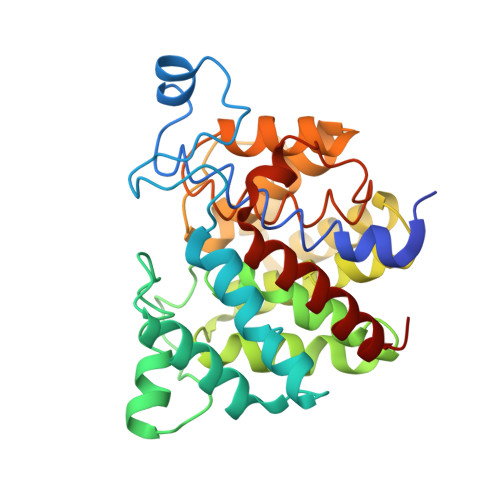Mechanism of Adp-Ribosylation Removal Revealed by the Structure and Ligand Complexes of the Dimanganese Mono-Adp-Ribosylhydrolase Drag.
Berthold, C.L., Wang, H., Nordlund, S., Hogbom, M.(2009) Proc Natl Acad Sci U S A 106: 14247
- PubMed: 19706507
- DOI: https://doi.org/10.1073/pnas.0905906106
- Primary Citation of Related Structures:
2WOC, 2WOD, 2WOE - PubMed Abstract:
ADP-ribosylation is a ubiquitous regulatory posttranslational modification involved in numerous key processes such as DNA repair, transcription, cell differentiation, apoptosis, and the pathogenic mechanism of certain bacterial toxins. Despite the importance of this reversible process, very little is known about the structure and mechanism of the hydrolases that catalyze removal of the ADP-ribose moiety. In the phototrophic bacterium Rhodospirillum rubrum, dinitrogenase reductase-activating glycohydrolase (DraG), a dimanganese enzyme that reversibly associates with the cell membrane, is a key player in the regulation of nitrogenase activity. DraG has long served as a model protein for ADP-ribosylhydrolases. Here, we present the crystal structure of DraG in the holo and ADP-ribose bound forms. We also present the structure of a reaction intermediate analogue and propose a detailed catalytic mechanism for protein de-ADP-ribosylation involving ring opening of the substrate ribose. In addition, the particular manganese coordination in DraG suggests a rationale for the enzyme's preference for manganese over magnesium, although not requiring a redox active metal for the reaction.
Organizational Affiliation:
Department of Biochemistry and Biophysics, Stockholm Center for Biomembrane Research, Arrhenius Laboratories for Natural Sciences, Stockholm University, SE-10691 Stockholm, Sweden.


















